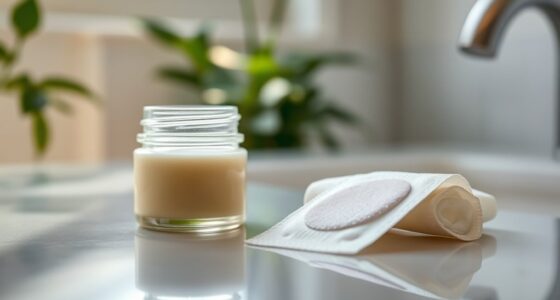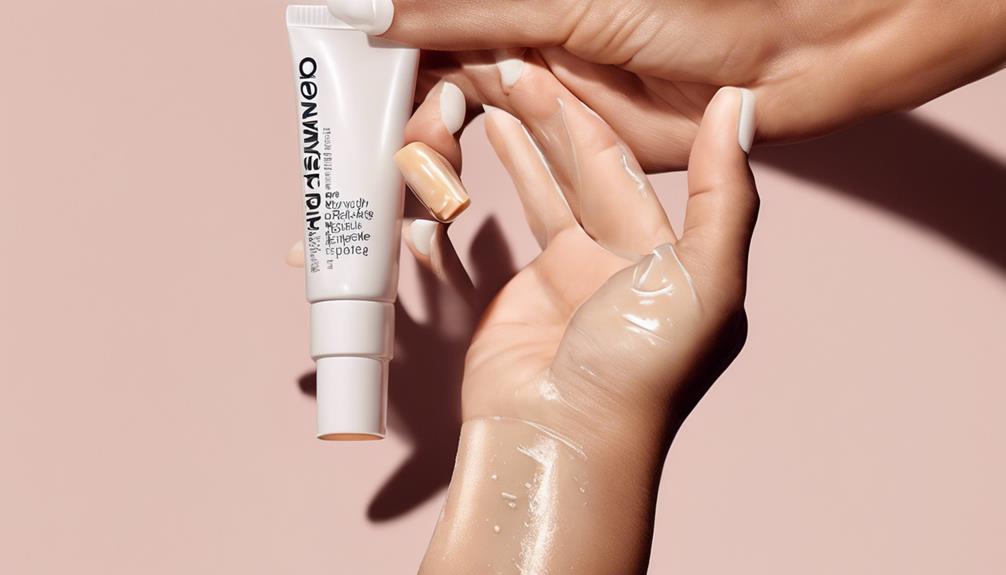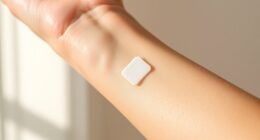Pimple patches primarily target breakouts, and their effectiveness on blackheads is limited. They absorb oil but don't extract blackheads like pore strips do, which can sometimes trap bacteria and worsen the issue. While they create a moist environment for healing, they won't address the underlying causes of blackheads. For better results, consider combining patches with treatments like salicylic acid or retinoids. You'll discover more about how to optimize your acne routine.
Key Takeaways
- Pimple patches primarily absorb fluid, making them less effective for blackheads, which are clogged pores with oil and dead skin.
- Unlike pore strips, pimple patches do not extract blackheads; they can trap bacteria and oil, potentially worsening the issue.
- Combining pimple patches with treatments like salicylic acid or retinoids may provide better results for managing blackheads.
- Pimple patches create a moist healing environment, but they do not address the underlying causes of blackheads.
- They are more effective on inflammatory acne rather than non-inflamed lesions like blackheads.
Understanding Pimple Patches and Their Purpose

While you might be familiar with various acne treatments, pimple patches offer a unique solution for managing breakouts. These small, adhesive stickers work by absorbing impurities while protecting your skin from further irritation.
There are different types of patches, including hydrocolloid, medicated, and microneedling options. Hydrocolloid patches absorb excess oil, while medicated ones contain ingredients like salicylic acid or tea tree oil to target bacteria. Hydrocolloid acne pads are especially effective for treating individual, surface-level pimples due to their ability to absorb excess fluid.
The primary purpose of these patches is to prevent picking and reduce inflammation, making them suitable for all skin types, including sensitive skin. They're especially effective for inflammatory acne, although they're less impactful on blackheads.
How Pimple Patches Function

Pimple patches function by creating a controlled environment that promotes healing while protecting your skin. Made primarily from hydrocolloid, these gel-like patches absorb excess fluids, such as pus and oil, effectively reducing inflammation and size. This is particularly helpful for other types of acne lesions, but pimple patches may not effectively treat blackheads as they require the removal of oil and dead skin cells from within the pore.
By forming a protective barrier, they shield your pimple from external contaminants, minimizing the risk of infection. The hydrocolloid material also maintains a moist environment, which accelerates healing and helps prevent scarring.
As the patch absorbs fluids, it turns white, signaling effective absorption. Additionally, by occluding the pimple, these patches prevent picking, further irritation, and bacterial spread, while reducing friction from external factors.
Effectiveness of Pimple Patches for Blackheads

Though pimple patches offer benefits for healing inflamed acne, their effectiveness on blackheads is limited. These patches primarily absorb excess oil but don't physically extract blackheads like pore strips do. While they can protect your skin from irritation and picking, you might find that they can sometimes trap bacteria and oil, potentially worsening your blackheads. For better results, consider combining pimple patches with treatments like salicylic acid or retinoids, which are more effective for dissolving blackhead blockages. Additionally, reducing sebum can help prevent clogged pores and may lead to fewer blackheads over time. Remember, while pimple patches can reduce inflammation, they won't tackle the underlying causes of blackheads.
Benefits and Limitations of Using Pimple Patches

Although they can be an effective tool in your skincare arsenal, pimple patches come with both benefits and limitations that you should consider.
On the plus side, they're easy to use and can be worn discreetly under makeup, providing a protective barrier that helps reduce inflammation by absorbing excess oil and pus. Plus, you can find a variety of types to suit your skin needs. Additionally, they are often made of hydrocolloid material, which helps in creating a moist environment for healing.
However, they're not suitable for deeper acne like blackheads or cystic lesions and won't solve underlying acne issues. Some active ingredients may irritate sensitive skin, and they don't prevent future breakouts.
Ultimately, while pimple patches can aid in managing surface-level breakouts, they shouldn't replace a thorough skincare routine.
Best Practices for Applying Pimple Patches

To get the most out of your pimple patches, following best practices for application is key.
Start by cleansing your skin thoroughly and patting it dry with a clean towel. Choose a patch that fits the pimple without overlapping others, as this prevents irritation.
Cleansing your skin and choosing the right patch size are essential steps to prevent irritation and ensure effectiveness.
Apply the patch smoothly, pressing it down for a few seconds to eliminate air bubbles. Aim to leave the patch on for at least six hours, preferably overnight, but avoid exceeding ten hours. For optimal results, ensure your skin is completely dry before applying the patch.
After removing the patch, gently clean the area and avoid strong treatments to minimize irritation.
Finally, monitor your skin's response to track progress and adjust your routine as needed.
Frequently Asked Questions
Can Pimple Patches Be Used on Other Types of Acne?
Yes, you can use pimple patches on various types of acne, but their effectiveness varies.
They work well on surface-level pimples like whiteheads and pustules, absorbing pus and reducing inflammation.
However, they're not suitable for deeper cystic acne. If you're dealing with inflammatory acne, consider microneedle patches that deliver active ingredients deeper into the skin.
Just remember, for blackheads, traditional treatments like retinoids are a better choice.
How Often Can I Use Pimple Patches?
You can use pimple patches daily if needed, making them a convenient part of your skincare routine.
After cleansing and toning, let the area dry before applying the patch. For best results, leave it on for at least six hours or overnight.
Consistency is key, so regular use can help you manage acne effectively.
Just remember, they're most effective as part of a broader skincare regimen for ideal results.
Are There Any Side Effects of Using Pimple Patches?
You know what they say: "A stitch in time saves nine."
When it comes to pimple patches, there can be side effects. Some users experience skin irritation or dryness, especially on sensitive skin. While they're great for preventing picking, improper use might trap bacteria and worsen breakouts.
It's crucial to patch test new products to avoid adverse reactions. Always listen to your skin, and don't hesitate to consult a dermatologist if needed.
Can I Use Pimple Patches on Open Wounds?
Yes, you can use pimple patches on open wounds. They create a moist environment that helps with healing and protects the area from irritation.
When applying them, make sure the patch adheres smoothly for maximum effectiveness. Just keep in mind that if the wound is too wet, the patch mightn't stick well.
Always monitor the wound's condition, and if you notice any signs of infection, consult a healthcare professional.
Do Pimple Patches Expire or Lose Effectiveness Over Time?
Yes, pimple patches can expire or lose effectiveness over time.
If you store them improperly, like in a humid environment, their adhesive may weaken, and active ingredients can degrade.
It's important to keep them in a cool, dry place and follow the manufacturer's guidelines for storage.
Conclusion
To sum up, while pimple patches can be effective for certain types of acne, they're not the best solution for blackheads. Imagine you're prepping for a big event and decide to use a pimple patch on a stubborn blackhead. After hours of waiting, you find it's barely changed. Instead, consider exfoliating or using a clay mask for better results. Understanding how to treat your skin can lead to clearer, healthier skin in the long run.
Claire has a knack for turning complex dermatological concepts into engaging, easy-to-understand articles. Her work primarily focuses on creating detailed reviews and thought-provoking articles in the “Vetted” category. Claire’s writing not only informs but also inspires our community to try new skincare solutions.










